
:max_bytes(150000):strip_icc()/001_Android_Launchers_4685951-8663b5a00c1d4284a46fc8ea8f971d57.jpg)
If set to True, the wallpaper in the policy will only be enforced for the initial deployment.If you define the grid size, the maximum number of apps that will be shown in a row on the home screen would be the number of rows you set and the maximum number of apps that will be shown in a column in the home screen would be the number of columns you set.Ĭom.Īllows you to set a wallpaper of your choice by entering the URL of the image that you want to set as a wallpaper.Īllows you to specify if the Set Device Wallpaper setting can be changed by the end user.

You can set the number of app rows and columns to define grid size in the following format: columns rows. Note: The Home Screen App order can only be configured via the JSON editor.Ĭom.UserChangeAllowedĪllows you to set the grid size for apps to be positioned on the home screen.

Using Configuration DesignerĬonfiguration designer allows you to select pre-populated settings and their associated values. All previously configured settings will be preserved and you can switch to use the configuration designer to modify supported settings. When editing previously created app configuration policies, if complex properties have been configured, the edit process will display the JSON Data editor. To add additional configuration keys into the JSON Data, use the JSON script example to copy the necessary lines for each configuration key. Once properties are configured via the Configuration Designer, the JSON data will also be updated to only reflect these properties. If you add properties with Configuration Designer, you can automatically convert these properties to JSON by selecting Enter JSON data from the Configuration settings format dropdown list as shown below. JSON data allows you to define all possible configuration keys using a JSON script. These configuration keys can only be configured by entering JSON data. In this method, there are a few disabled configuration keys with value type BundleArray. There are two methods that you can use to define configuration settings for Microsoft Launcher:Ĭonfiguration designer allows you to configure settings with an easy-to-use UI that lets you toggle features on or off and set values.

Click on Configuration settings to configure the different available Microsoft Launcher settings. Add a configuration policy for Managed devices running Android and choose Microsoft Launcher as the associated app. Once the Microsoft Launcher application has been added to Intune, navigate to the Microsoft Endpoint Manager Admin Center and select Apps > App configuration policies.
#Microsoft launcher on android tablet how to#
How to configure the Microsoft Launcher app This standardizes the look and feel of all managed Android devices across different OEM devices and system versions. On Android Enterprise fully managed devices, Launcher allows enterprise IT admins to customize managed device home screens by selecting the wallpaper, apps, and icon positions. Microsoft Launcher is an Android application that lets users personalize their phone, stay organized on the go, and transfer from working from their phone to their PC.


 0 kommentar(er)
0 kommentar(er)
